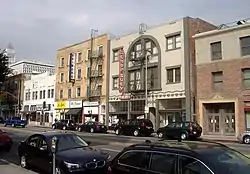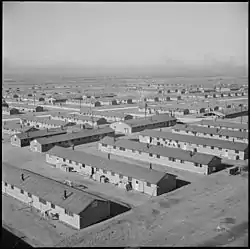Chiyoko Sakamoto
Chiyoko Sakamoto (1912–1994) was California's first Japanese American female lawyer.[1]
Chiyoko Takahashi | |
|---|---|
| Born | Chiyoko Sakamoto Takahashi June 30, 1912 Napa, California, U.S. |
| Died | December 2, 1994 (aged 82) |
| Alma mater | American University Washington College of Law |
| Employers |
|
| Organization(s) | Japanese-American Bar Association and the California Women's Bar (founder of both) |
| Spouse | Tohru Takahashi |
| Parent(s) | Hisamatsu and Kume Sakamoto |


Sakamoto was born on June 30, 1912, in Los Angeles, California, to Hisamatsu and Kume Sakamoto.[2][3] In 1938, she was admitted to practice law shortly after graduating from the American University Washington College of Law in Los Angeles, California.[4] Sakamoto worked as a secretary during the four years of her legal studies.[5] She became a legal assistant for a Japanese-American community leader after searching in vain for a law firm position.[6][7]
During World War II, following the signing of Executive Order 9066, Sakamoto was imprisoned in the Granada Internment Camp in Prowers County, Colorado.[8] Upon being released in 1947, she struggled yet again with finding employment.[9] Through her struggles, she met Harvard University-educated African-American attorney Hugh E. Macbeth Sr., who was a staunch defender of Japanese-Americans. He hired Sakamoto as an associate at his Los Angeles-based law firm. Sakamoto's coworkers included Eva M. Mack, a lawyer who worked with Macbeth Sr. on the California Supreme Court case Davis vs. Carter that pertained to a housing discrimination suit filed by jazz musician Benny Carter.[10][11][12] At the time, Sakamoto was unique in working for a non-Nisei law firm.
She eventually opened her own law firm in Little Tokyo, Los Angeles and was one of the founders of the Japanese-American Bar Association and the California Women's Bar.[4] Sakamoto's husband, Tohru Takahashi,[13] was a farmer in New Mexico, and they owned various farms in California (she even managed some of them while simultaneously taking on cases).[14]
Sakamoto died in 1994.
References
- Watson, Jonathan. "Legacy of American Female Attorneys (2016 rev.)" (PDF). Solano County Law Library. Archived from the original (PDF) on March 7, 2016. Retrieved October 6, 2016.
- "Sakamoto-Sasano Family Collection". janm.emuseum.com. Retrieved 2019-08-31.
- Saito, Matthew. "Chiyoko Sakamoto, a Trailblazer and Innovator of the Nikkei Community". Discover Nikkei. Retrieved 2022-03-08.
- Parker, Monica R. (2010). What it Takes: How Women of Color Can Thrive Within the Practice of Law. American Bar Association. ISBN 9781590319925.
- "Society News". The Daily Chronicle. October 27, 1938. Retrieved 2019-08-23.
- Beaton, Gail M. (2012-11-15). Colorado Women: A History. University Press of Colorado. ISBN 9781457173820.
- Beitiks, Kathleen. "Women in the Law: The Early Years" (PDF). State Bar of California: Celebrating 75 Years.
- "Japanese American Internee Data File: Chiyoko Sakamoto". National Archives and Records Administration. Retrieved November 3, 2019.
- Matsumoto, Valerie J. (2017-03-02). City Girls: The Nisei Social World in Los Angeles, 1920-1950. Oxford University Press. ISBN 9780190655204.
- "Davis v. Carter". Justia Law. Retrieved 2019-08-23.
- Robinson, Greg (2016-09-01). The Great Unknown: Japanese American Sketches. University Press of Colorado. ISBN 9781607324294.
- Brilliant, Mark (2010-10-21). The Color of America Has Changed: How Racial Diversity Shaped Civil Rights Reform in California, 1941-1978. Oxford University Press. ISBN 9780199798810.
- "Legal Secretaries To Host Only Nisei Woman Attorney on Coast". Shin Nichibei. July 14, 1961. Retrieved 2019-08-31.
- The Other Two JA women lawyers in Los Angeles—Chiyoko Sakamoto and Madge Watai, retrieved 2019-08-23